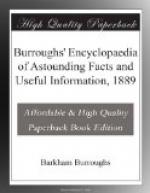Protecting Water-Pipes Against Frost.—A device has been brought forward for protecting water-pipes against freezing, the arrangement being based upon the fact that water in motion will remain liquid at a lower temperature than water at rest. One end of a copper rod, placed outside the building, is secured to a bracket, and the other end is attached to one arm of a weighted elbow lever; to the other arm of the lever is secured a rod which passes into the building and operates a valve in the water-pipe. By means of turn buckles the length of the copper rod can be adjusted so that before the temperature reaches the point at which there would be danger of the water in the pipes freezing the valve will be opened to allow a flow of water; beyond this point the valve opening will increase and the flow become more rapid as the cold becomes more intense, and as the temperature rises the valve is closed. This plan sets up a current in the pipes, which replaces the water as it grows cold by the warmer water from the main.
Destructive Work of Barnacles.—Unless some paint can be found which is proof against barnacles, it may be necessary to sheath steel vessels with an alloy of copper. An attempt has been made to cover the hulls with anti-corrosive paint and cover this with an outside coat which should resist the attack of barnacles. Somehow the barnacles eat their way through the paint and attach themselves to the hull. The vast item of expense attached to the dry-docking of steel ships makes this matter a not unimportant one. The barnacles interfere greatly with the speed of a vessel, and in a cruiser speed is of prime importance. They attach themselves in an incredibly short time to a steel hull, and it is not long before their effect can be noted by a comparison of the reading of the log.




